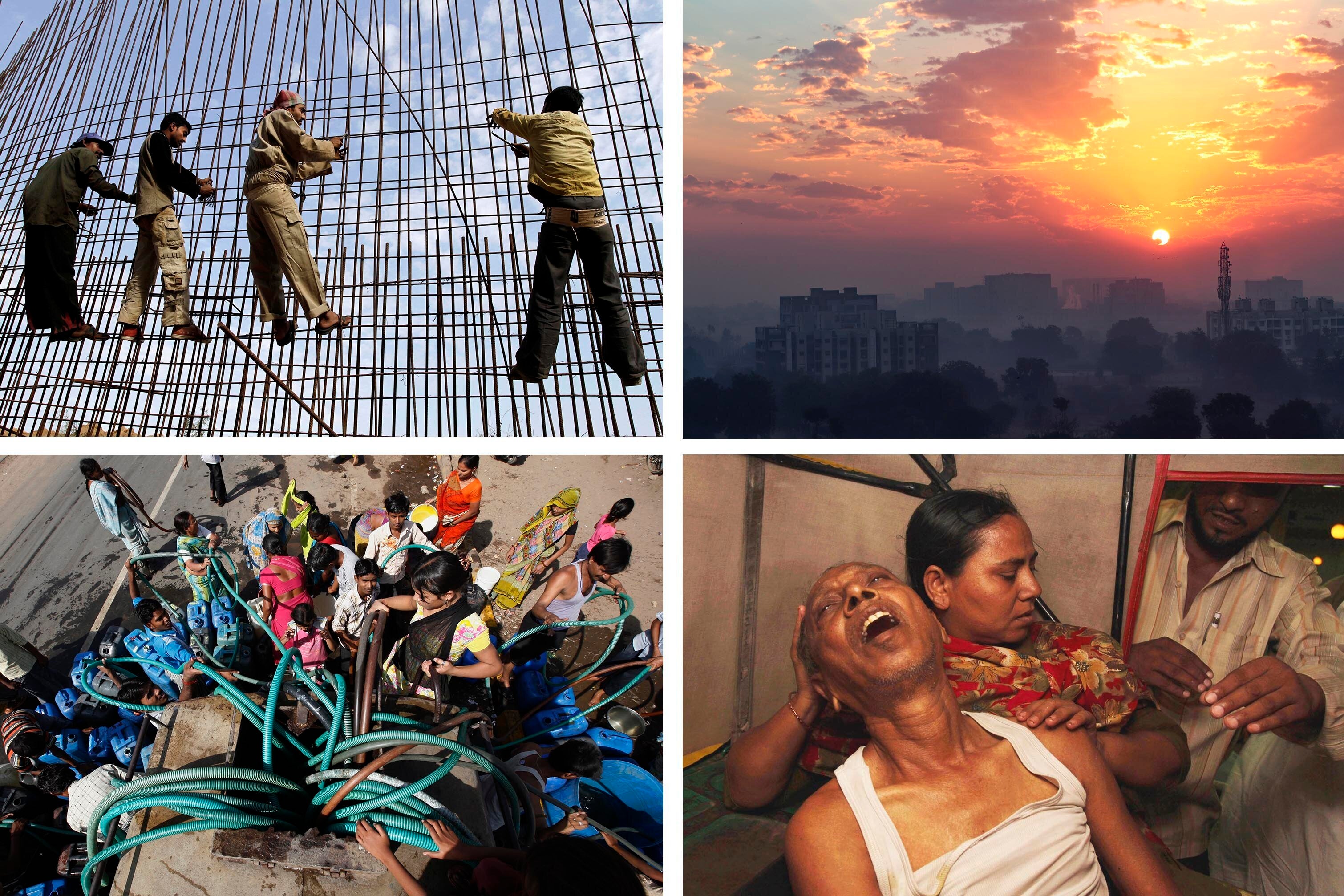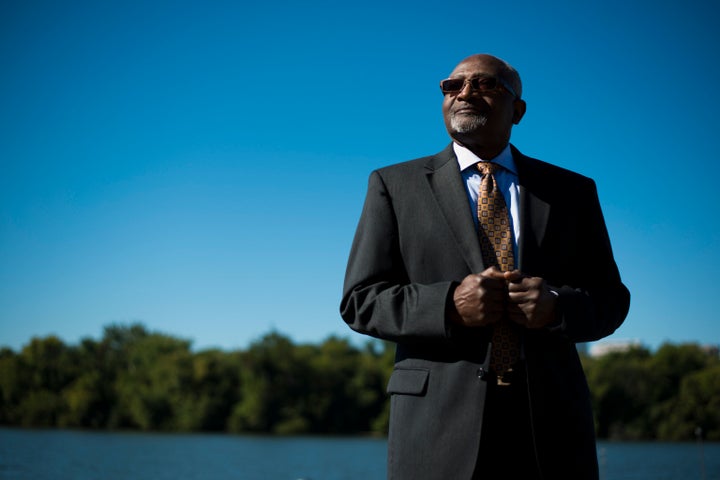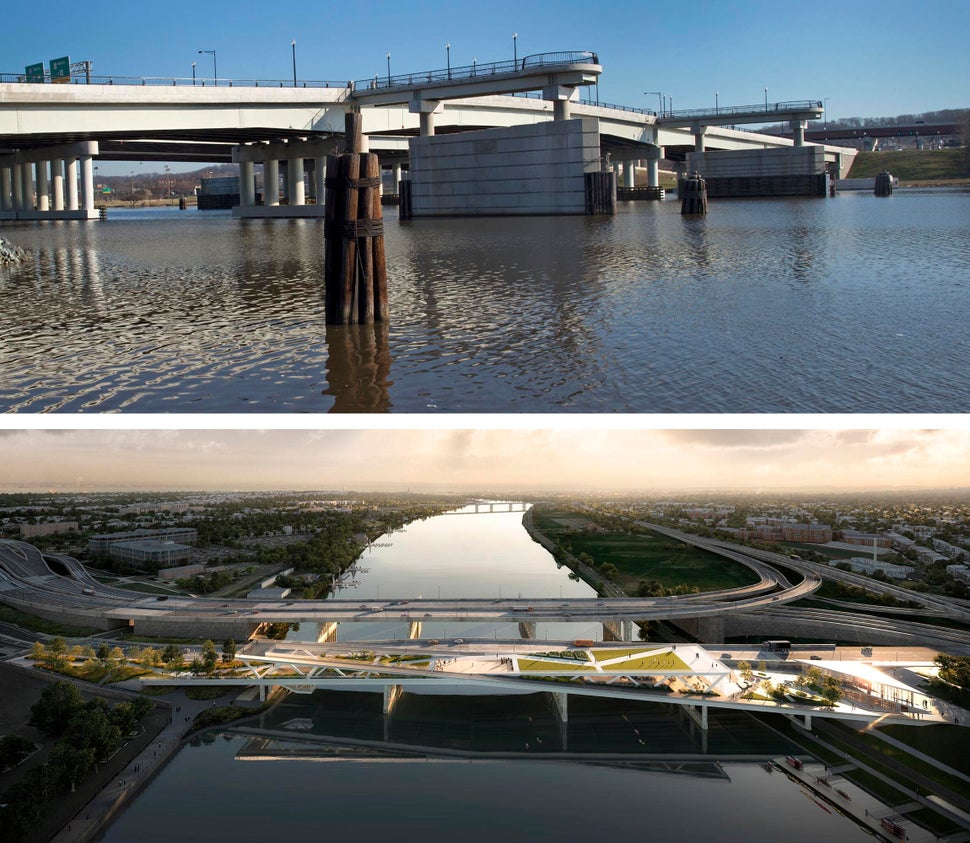FutureProof is a collaboration between HuffPost and Unearthed, Greenpeace UK’s journalism unit
When the summer heat pounds his city, Kumar Manish sleeps out on his balcony to take refuge from the stifling temperatures indoors. Temperatures in the western Indian city of Ahmedabad regularly top 100 degrees Fahrenheit, and people often joke that there are only three kinds of weather here: hot, hotter and hottest.
“Ahmedabad heat in peak summer season feels like you are sitting in a furnace,” said the 37-year-old communications and social media strategist, who has lived and worked in the city for 14 years. Even basic tasks turn into endurance tests. On a hot day, Manish’s short motorcycle trips around the city take twice as long as usual, punctuated by stops at roadside sugarcane stands to rehydrate and take shelter from the punishing sun.
The city of roughly 8 million people has long been familiar with heat. But, exacerbated by climate change, its historically hot summers have been turning into something much more extreme. In 2010, a devastating heat wave sent temperatures soaring to over 116 degrees Fahrenheit (47 degrees Celsius). Medical facilities were inundated with patients struggling from heat-related conditions. A public hospital serving some of the poorest residents in the city reported a surge in admissions of newborns to intensive care due to the searing heat. More than 1,300 people died.
As the climate crisis deepens, temperatures are rising. Extreme heat is one of the deadliest and most pernicious consequences of climate change. And cities — home to more than half the world’s population — are uniquely vulnerable thanks to a phenomenon called the “urban heat island effect.” Dark roads and pavements absorb heat, tall buildings cause air to stagnate, and road traffic and industrial activity spew out heat and dangerous amounts of greenhouse gas emissions.

Much like a pandemic, when a heat wave hits a city, it doesn’t just kill people — its rippling effects wreak havoc across society, straining health services, causing power outages, buckling railways, decreasing worker productivity, and causing intimate partner violence to spike. And those overlapping consequences don’t fall equally. Again, like a pandemic, heat finds and exacerbates inequalities already baked into the physical and social infrastructure of a city, hitting low-income neighborhoods and people of color the hardest.
The last five years have been the hottest recorded, and 2020 could be hotter still. Every year, as heat records are smashed, cities swelter and people suffer.
As cities grow over the coming decades, the stakes will get higher: By 2050, 2 in 3 people on Earth will live in an urban area. The solutions boil down to tackling climate change, slashing emissions and halting reliance on fossil fuels. But the pace of international action runs glacially slow, and the impacts of the climate crisis are here, right now. Cities everywhere need to adapt, fast.
Ahmedabad is just one of thousands of cities facing this formidable challenge — but it has a plan.
The devastating loss of life in Ahmedabad’s 2010 heat wave led to a reckoning in the city. “No one should be dying from extreme heat. It is entirely preventable,” said Anjali Jaiswal, senior director at the Natural Resources Defense Council, India, one of the organizations that partnered with the city government to devise a response.
The largest city in the state of Gujarat, Ahmedabad is one of India’s fastest-growing cities. Migration from neighboring states and abroad is on the rise, with many coming to the city for temporary construction work. The rapidly expanding metropolis has as many as 50,000 construction workers, whose poorly paid, poorly regulated outdoor labor puts them at high risk of heatstroke, exhaustion and other dangerous health problems. And around 900,000 people live in Ahmedabad’s crowded, heat-vulnerable slum communities.
Any plan to minimize the effects of heat has to include those most at risk. “You need to stay hydrated and stay in a cool place to seek medical attention, but you need to get that fast. And so what we did was create a system that supports that, and a system that really focuses on the most vulnerable communities,” said Jaiswal.
Ahmedabad’s heat action plan, the first version of which was published in 2013, concentrated on four key areas: community outreach through news outlets and social media like WhatsApp; early-warning systems; special training for health care professionals; and preventive measures such as installing drinking water stations in the city’s slums, opening up temples, mosques and libraries as cooling centers, and providing ice packs to outdoor workers.
And it worked. Five years after the 2010 heat wave, when a similar heat wave swept across India, killing thousands, Ahmedabad had fewer than 20 fatalities.
And while residents like Manish are still forced to find innovative ways to make the heat bearable, at least the city is now prepared.
Ahmedabad has since been hailed as a model for heat resilience. “This has really been a community-based program with city residents, businesses all working together to protect the community from extreme heat,” said Jaiswal.
“Building up social resilience is an aspect of climate preparedness that sometimes doesn’t get as much airplay,” said Priya Mulgaonkar, resiliency planner for the New York City Environmental Justice Alliance.
Community-focused social measures like those in Ahmedabad may not look as impressive as headline-grabbing cooling schemes like soaring vertical gardens on skyscrapers, but Mulgaonkar says they are one of the easiest, most affordable and most effective ways to keep vulnerable communities safe in a heat emergency. “It’s not glossy and futuristic, but it works.”
These lower-profile but crucial fixes are not unique to India; 7,500 miles west of Ahmedabad, a similar project is being piloted in New York City.
Residents of the Bronx suffer more heat-related illnesses, hospitalization and mortality than those in New York City’s other boroughs. Only a few miles from the northern tip of Manhattan’s Central Park, where luxury apartments, upscale shops and trees neatly line busy 5th Avenue, the predominantly low-income Black and brown South Bronx neighborhood of Hunts Point is acutely affected by extreme heat.
“Our location makes us very unique in our experience of heat even compared to other parts of the South Bronx, because it’s an urban heat island hot spot,” said Dariella Rodriguez, director of community development for The Point Community Development Corporation, known as The Point CDC, a nonprofit that raises awareness about environmental hazards in the South Bronx.
Heavy industry such as waste transfer stations, power plants and high concentrations of truck traffic contribute to Hunts Point’s heat vulnerability — as does the dearth of trees and parks, which reflects a historical lack of green infrastructure investment in low-income neighborhoods of color across the United States.
But Hunts Point’s strength is its tight-knit community. In 2018, The Point CDC launched an initiative called the Be A Buddy program in collaboration with the city government. It identifies vulnerable residents — elderly people living alone, people with disabilities or people living in low-quality housing, for example — whom neighborhood volunteers can reach out to during a heat wave. The program has seen considerable success, according to an NYC-EJA report, with 100 people enrolled and more than 500 people reached during a summer heat wave in 2019.
“Be A Buddy started as a program to address heat, but quickly, we realized that these people who are most vulnerable to heat issues are also most vulnerable to other things like the need for food, unemployment, and COVID-19,” said Rodriguez. “We see [the program] as not just about heat. We see it as a way communities can build and depend on each other, and become the experts in times of emergency.”
Social resilience is crucial to protecting cities in a heat wave, but since the urban heat island effect is largely driven by the basic physical fabric of a city, modifying that fabric is another vital way to reduce the human cost of extreme heat.
These can be simple fixes ― like a change of color. When the 2010 heat wave hit Ahmedabad, the black tar roof of the municipal Shardaben hospital absorbed the sun’s heat. Underneath this roof, the highest and hottest floor of the hospital housed the maternity ward. The number of newborns requiring intensive care leaped during the heat wave.
When Jaiswal visited the hospital in 2014, the ward had been moved to the ground floor and the roof covered with a white reflective china mosaic to lower indoor temperatures as part of the city’s cool roofs program. In a hospital with no air conditioning serving some of the city’s poorest residents, these simple modifications to the building and its layout made a significant difference.
Moving the maternity ward was found to have a protective effect, too, and eight more health centers in the city have since installed cool roofs.
White roofs are catching on as one relatively simple response to heat. New York City’s $106 million initiative Cool Neighborhoods NYC — of which South Bronx’s Be a Buddy program is a part — is coating roofs with white reflective paint. On the hottest day of a New York summer, a white roof could be as much as 42 degrees Fahrenheit (23 degrees Celsius) cooler than a typical black roof. In Los Angeles, where more than 10% of the city’s land surface is heat-trapping black asphalt, city authorities are installing California’s first white, reflective road coatings. LA aims to cover around 1,500 of its most heat-affected blocks over the next decade.
Cities are also deploying nature-based fixes. Ahmedabad plans to plant half a million trees a year between 2020 and 2025. Trees provide vital shade, with their canopies blocking up to 90% of the sun’s radiation. On a hot day in some parts of the world, taking shelter under a tree can make the air feel up to 15 degrees Celsius (27 degrees Fahrenheit) cooler on our skin.
In Medellín, Colombia, a network of green corridors – interconnected avenues lined with trees and other plants – help lower temperatures along some of the city’s busiest roads, while also drawing pollutants out of the air and storing carbon.
But since cooling infrastructure’s effects are largely local, where you put it determines who benefits. In Vancouver, Canada — a “green” city with nearly 25% tree cover and where 92% of its residents live within a five minute walk of green spaces — the city’s poorest neighborhoods have the least protection and suffer the worst heat.
The same is true in the U.S., where communities of color are three times more likely than white communities to live in nature-deprived places. A 2019 study of 108 American cities found that 94% of historically redlined neighborhoods are consistently hotter than other areas in the same city.
It’s a result of the systemic racism exemplified by redlining – a government-sanctioned effort to segregate communities of color by refusing to give them housing loans and insurance. Redlining gave birth to unjust legacies, including a lack of trees and green spaces, that still put people of color at greater risk of extreme heat almost a century later.
No matter how technically clever a cooling measure is, if planners fail to deploy it in the right places, the already-stark temperature disparity between deprived and affluent neighborhoods will only worsen.
“When it comes to urban solutions, we [need to be] big proponents of green infrastructure equity, and making sure that the co-benefits of things like rain gardens or green roofs are prioritized for historically marginalized communities,” Mulgaonkar said.
It matters who gets to design the solutions.
“In many cases, the people leading climate action plans in cities don’t reflect the demographics of the city,” said Robert Bullard, professor of urban planning and environmental policy at Texas Southern University, also known as the father of environmental justice. “If we’re not careful in implementing equitable measures, the most vulnerable will still be the most vulnerable. The most marginalized will still be the most marginalized.”

Without careful consultation and planning, building green infrastructure in the neighborhoods that need it most can have the perverse effect of raising property prices and forcing residents out, a phenomenon known as climate, or green, gentrification.
“The entire idea of green gentrification is that you prioritize the green without considering what the impacts are on affordable housing, low-income residents or local small businesses,” said Alessandro Rigolon, assistant professor for city and metropolitan planning at the University of Utah. Green infrastructure has to be accompanied by anti-displacement strategies, he added, in order to serve the local population — like rent control and anti-eviction policies that ensure the intended beneficiaries can stick around to feel the cooling effects.
“We can’t just say, hey, let’s slap some trees around and that’s going to be better,” said The Point CDC’s Rodriguez. “We have to say, what are all the problems that are currently going on? How are people using the streets and the current infrastructure that we have? How do we look at these locations as priorities and uplift community projects, like community gardens, like planting more trees in neighborhoods that are hotter?”
The 11th Street Bridge Park in Washington, D.C., serves as a good model for this type of equitable urban design, said Rigolon. By 2023, the bridge, which connects the city’s Capitol Hill and Anacostia neighborhoods, will be transformed from a busy highway to an elevated green park, with community gardens, a recreational space and an environmental education center.

At first, the planned development raised fears of displacement and gentrification among Anacostia’s predominantly Black community. Recognizing the growing opposition, project leaders set aside the original plans and instead spent years listening to the community’s concerns in order to co-produce an “equitable development plan.”
The plan includes a community land trust that essentially buys up property in the neighborhood to house residents otherwise at risk of displacement, ensuring affordable housing and shielding them from development pressure. To combat high unemployment in the neighborhood, the plan guarantees jobs such as construction and maintenance work in the park for residents facing employment security challenges — particularly formerly incarcerated people and young people.
Urban planning and environmental policy experts like Bullard and Rigolon believe that to challenge the disproportionate impact of the climate crisis on vulnerable communities, cities need to start radically rethinking public space and services — making changes that protect all inhabitants.
.
.
“In the climate crisis, much like COVID-19, our battle for the planet is the same as our battle for equity.”
ANJALI JAISWAL, SENIOR DIRECTOR
AT THE NATURAL RESOURCES DEFENSE COUNCIL, INDIA
.
.
One of Rigolon’s favorite initiatives is Barcelona’s “superblocks,” an urban design concept intended to limit car use in response to high air pollution levels in the city. Each superblock is a grid of nine blocks where streets are closed to through traffic and lined instead with cycle lanes, parks, play areas and outdoor seating. A 2019 study from the Barcelona Institute for Global Health estimates that if the city built all of its planned 503 superblocks, it could save 667 lives each year — 117 of which would be saved by reducing the urban heat island effect.
“What is important for me with the superblocks is that [the city] chose the blocks that had a huge social housing scene,” said Rigolon, “because not only did they want to bring those public spaces to people who needed it the most, but they also wanted to make sure they didn’t displace people.”
Heat is a complex threat, one that’s hard to escape and that poses the greatest risk to those with the fewest resources. As the climate crisis accelerates, deaths from heat are predicted to rise sharply unless adaptation measures are taken now.
For the billions of people living in cities, there is no simple technical fix or silver-bullet solution that can protect them from the heat they’re experiencing now and the rising temperatures to come. There are answers to be found in the mix of projects already happening around the world. But to be truly resilient, we need to ask the question: Who are cities really for?
The coronavirus pandemic has shown, in the most brutal ways, that many of our cities are not designed to take care of their most vulnerable citizens in a crisis.
“In the climate crisis, much like COVID-19, our battle for the planet is the same as our battle for equity,” Jaiswal said. “If we cannot protect the most vulnerable in our communities now, we will all fail.”
While Ahmedabad’s plan to reduce heat vulnerabilities has proved successful, it needs to be constantly updated to continue adapting to a changing climate. In India, average temperatures are projected to increase by up to 7.9 degrees Fahrenheit (4.4 degrees Celsius) by 2100, and the frequency and duration of heat waves are forecast to intensify, according to United Nations climate models.
“The biggest thing we all need to do right now is to act boldly and rapidly,” said Jaiswal. “All of the technology and solutions, like the Ahmedabad heat action plan, are readily available to us. With the climate crisis, we need to act now. It is just a question of political will.”
As for Manish, when the temperature rises, he does what he can to adapt. He avoids traveling outdoors for unnecessary work meetings in the summer. At home, he puts up green bamboo curtains to assuage the punishing heat. And when he can, he escapes to nearby forests for sanctuary.
Ahmedabad’s brutal heat waves have not dulled his love for the city, though. “I was a stranger to the city when I first came here in 2006, but after a while, we got acquainted. Today, we’re in love,” he said. “The city, despite its harsh summers, is full of warmth for its people.”
Father to a 6-month-old daughter who will grow up in a world that will only get hotter, Manish has no intention of leaving Ahmedabad, the city with a plan.
.
.
.